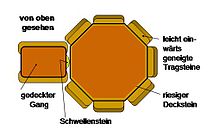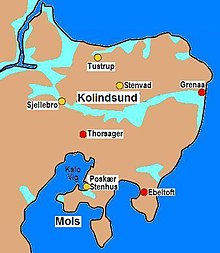Ginnerup Jyndovnen

The Langdolmen Ginnerup Jyndovnen ( German "Ginnerup Giant Oven" ) between the places Ginnerup and Godthåb is a megalithic facility of the funnel cup culture (TBK) in Djursland in the municipality of Norddjurs in Jutland in Denmark .
The name is derived from the Jutland term jynd ( German "giant" ); jyndovn is widely used as a popular name in Jutland ( Store Jyndovn ). Neolithic monuments are an expression of the culture and ideology of Neolithic societies. Their origin and function are considered to be the hallmarks of social development.
description
It is located north of Ginnerup on the Djursland peninsula in East Jutland near Grenaa . The area is rich in dolmens (e.g. Langdolmen Ildbjerggård ) and in many ways forms the southern counterpart to the concentration around Stenvad north of the silted up Kolindsund , from whose former south bank Ginnerup Jyndovnen was only a few 100 m away. These large stone graves date from the Neolithic period around 3500–2800 BC. Chr.
The long oval barren bed , presumably deprived of its curbs, is oriented east-west and measures 17 × 10 m. It only contains a polygonal pole . The polygonal chamber has a corridor in front of it and consists of six large bearing stones and the single capstone characteristic of dolmens of this type. The access to the chamber is in a gap between two of the southern bearing stones. The supporting stones are very close together and with their flat side facing inwards. The capstone was probably not covered with earth, because at the tip of the stone there are several pecked bowls , which usually come from the Bronze Age (1800–500 BC).
No archaeological excavations have been carried out nor any finds made. The way it looks today is the result of constant decline. The passage grave of Slemming is nearby .
See also
literature
- Poul Henning Jensen: Nature and culture guide for Århus County. Aarhus County, Aarhus 1997, ISBN 87-90099-21-4 .
- Karsten Kristiansen: På tur i Djurslands Fortid. Århus Amt - Landskabkontoret, Århus 1991 (Revideret, 3rd oplag. Ibid. 2002, ISBN 87-7906-246-6 ).
- Jakob Vedsted: Fortidsminder og Kulturlandskab. En kildekritisk analysis af tragtbaegerkulturens found material from Norddjursland. Forlaget Skippershoved, Ebeltoft 1986, ISBN 87-981329-5-4 .
Individual evidence
- ↑ Danish. Langdysser is the name commonly used in Denmark for dolmens that lie in a rectangular or trapezoidal barn bed, in contrast to this, round dolmen or round dysser are those dolmens that lie in a round hill
- ^ Johannes Müller : Neolithic Monuments and Neolithic Societies. In: Hans-Jürgen Beier , Erich Claßen, Thomas Doppler, Britta Ramminger (eds.): Varia neolithica VI. Neolithic Monuments and Neolithic Societies. Contributions from the meeting of the Neolithic Working Group during the annual meeting of the North-West German Association for Ancient Research in Schleswig, 9. – 10. October 2007 (= contributions to the prehistory and early history of Central Europe. Vol. 56). Beier & Beran, Langenweißbach 2009, ISBN 978-3-941171-28-2 , pp. 7-16, here p. 15.
Web links
Coordinates: 56 ° 25 ′ 2.4 ″ N , 10 ° 44 ′ 42.2 ″ E
